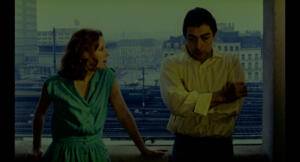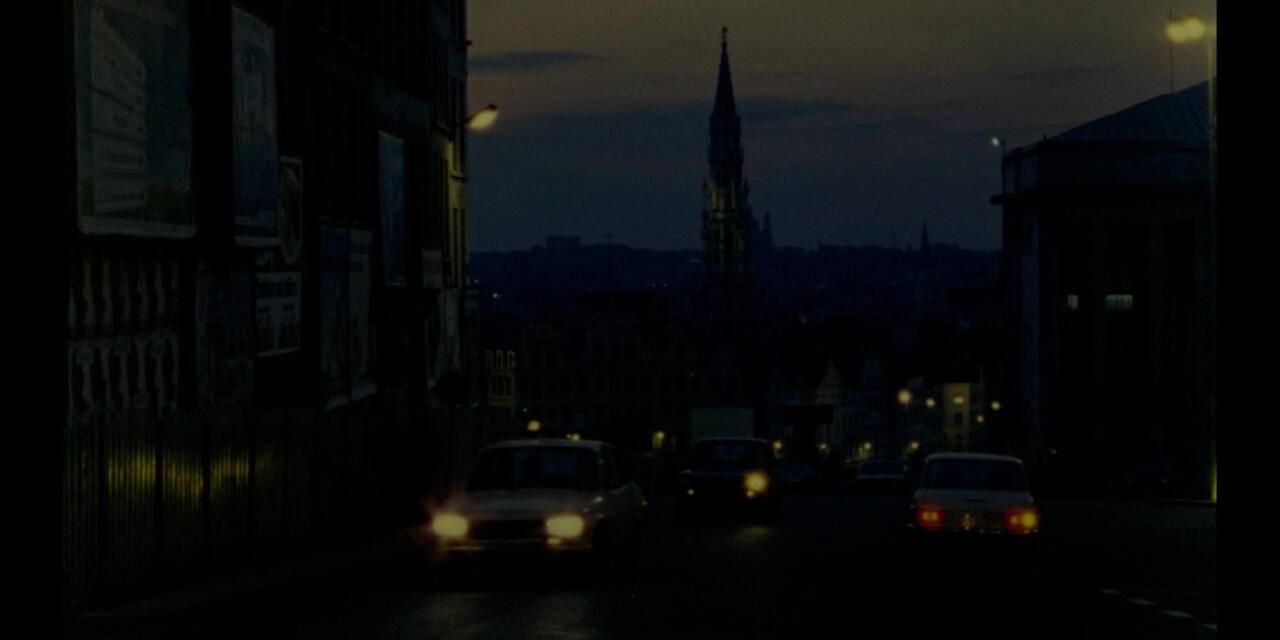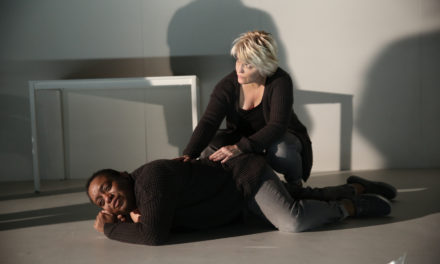Dance, the maternal and the push and pull against the form.
The feature length film Toute une nuit (1982), All Night Long, is an early work by the Belgian director Chantal Akerman (1950-2015). All Night Long is constructed through tableaux that come together as a sort of choreography made of multiple bodies, with no lead. As the title suggests, we follow these bodies “all night long” from dusk to dawn as they run to and from each other, examining the various possibilities of where and what they want to be. It is a warm summer night, as they are rare in the mostly rainy Brussels where the film is set.
The film is originally shot in 16mm in color, almost underexposed. This texture evokes a glimpse into the night where shapes are blurred and lights flicker. This atmosphere is established from the opening scene. A screening of a newly restored 35mm CRI copy scanned in 2K by Cinematek and under the supervision of Caroline Champetier, the original DOP1, was shown for the first time at Cinema Palace in Brussels on October 4th 2022.
While watching All Night Long, the spectator’s experience of time is almost realistic, an experience of an extended span of time and a gradual shift of light. This concern with time places the film in a lineage of female and feminist avant-garde filmmakers and artists in general. In 1946 filmmaker Maya Deren (1917-1961) wrote in An Anagram of Ideas on Art Form and Film: “special attention must be given to the creative possibilities of Time, and that the form as a whole should be ritualistic.” In this essay, I will attempt to place All Night Long as the work of a heiress of Deren’s thinking, of the daughter of Natalia (“Nelly”) and of a child of Brussels; leading to a reading of All Night Long as an ambivalent nocturnal ritual: simultaneously a tribute to heritage yet also an attempt of dancing oneself out of the demands of loyalty towards pleasure.
Some of the characters in this film dance with each other or desire “to go to dance in town”, 22:14. Dancing seems to represent a form of physical freedom, a counterpoint to confinement in this film and hints to the director’s ongoing interest in the (female) body and composing through it. This interest in dance is shared with Maya Deren. “By the early 1950s the latter begins to call all her films “choreographies for the camera”, or “cine-poems” (…) “cinema is a time-form and (therefore) it is really rather more closely related to music and dance than it is to any of the spatial forms, the plastic forms.””2
There are about 20 characters. They are restless, agitated, animated by desire for each other or to escape. They lie sleepless in bed, run, open doors, hug and let go of each other. Arms are recurrent, they reach out for another body or for keys and steps click on the streets. Couples find each other or separate. We are experiencing an almost burlesque, expressionist theatricality. Motifs, a tone and the embodiment of the push and pull of love and desire that to me evoke the Tanztheater of the German choreographer Pina Bausch (1940-2009), perhaps more specifically her piece Bandoneon (1980). In the following paragraphs until my paragraph about the appearance of Natalia her mother in real life, mimicking Akerman’s logic of self-portrait through her “body of work” in Chantal Akerman by Chantal Akerman (1993) and as Mc Fadden suggests in Enacted Reflexivity (2014), “as a way to escape what she perceives as critical confinement”, I will attempt to draw parallels between Akerman and Bausch during the beginning of the eighties and retrace how All Night Long came to be.
Bausch and Akerman share a common taste in costumes: Dressed up men in suits and women in dresses and high heels, pushing the adult’s gender performance to an extreme. Here they are mostly in the elementary colors: red, blue or yellow. Colors that are also repeated in the set. “In Pina Bausch’s Dance Theatre, confessions are simulations, unique identities assemblages of gender stereotypes, heartfelt gestures fiction. (…) Her repertory could be considered a revival of the “Ausdruckstanz” (…), in which “inner necessity”, a kind of emotional kinesthetic-honesty, was considered the choreographer’s most important resource. (…) The humanist model of self-expression that fueled the Audruckstanz choreographers is under critique in her work, as much as she reiterates it as a form of nostalgia. Bausch defamiliarizes “spontaneous” emotional and kinesthetic responses and rejects the idea that they stem from an essential inner self. She scrutinizes the social constructs that separate men and women into opposites.
To dissect solidified gender meanings, Bausch employs various strategies: juxtapositions of simultaneous, incongruous activities, a defiance of the time and space conventions of realism, and narrative fragmentation that disrupts the contexts of human behavior. She distorts ordinary patterns of movement and speech and isolates into bits that will not gel into conventional meanings.”3
While also standing in clear dialogue with the heritage of the “Ausdruckstanz” and, I feel, it is safe to assume, very inspired by discovering Bausch’s work a year earlier, in All Night Long Akerman is already a step ahead. She is free from the limitations of the live stage and in addition breaks away from the extreme heterosexuality present in all of Bausch’s works. The relationships depicted in the film reflect a wide spectrum of possible constellations between lovers. For example, at 9:28 a woman with two men, at 39:30 two women, at 54:09 two men. The gender binary established in costume with the adult figures is confronted by the presence of the ungendered teenager at 32:50 wearing black pants and a white T-shirt.
In the documentary Chantal Akerman made about the just 10-years older Pina Bausch in 1983, the year after making All Night Long, One day Pina asked…, Chantal says at 42:26 inserting herself physically into the film for that sequence sitting under an open window on the floor of a changing room that has a bed in it, also wearing black pants and a white T-shirt “when I watched one of Pina’s performances for the first time two years ago- it was Bandonean- I was overcome by an emotion I can’t quite define. But it was very, very strong, and had something to do with happiness. And now we’ve been watching her for fifteen days, we’ve been watching her as she works, we’ve seen rehearsals, performances and rehearsals, and something else has really happened. There really have been moments during which I felt I had to defend myself from what was being expressed, moments in the performance where I had to close my eyes. And at the same time, I can’t understand why.”
From the perspective of 2022, where I’m now sitting in front of my computer in Chicago on mother’s day finishing-off this essay, it seems obvious why a lesbian daughter of a Polish holocaust survivor deported from Brussels first to the Malines camp, then Auschwitz where all her family was murdered, raised in Belgium, a deeply catholic country, that has covered it’s collaborationist past during the holocaust under the glorification of individual stories of resistance sometimes had to defend herself by closing her eyes. But I need to keep in mind the extra-subjective time Kristeva writes about that I will describe below and remember that I am looking at the 1980’s. “Only” 40 years after the holocaust, 20 years before the legalization of gay marriage in Belgium. Times were different. Another 40 years have passed since then.
“Pina Bausch was 5 years old when the Nazis were defeated and Hitler committed suicide. (…) each of Bausch’s productions stirs thoughts of the Holocaust–in the hollow, cadaverous eyes of the victims, the near-naked bodies, the look of a community of the damned, the wallowing in cruelty, the feeling of spiritual asphyxiation. Bausch’s obsession with pathology seems all the more insidious for being, in all likelihood, mostly unconscious and unintentional in its implicit glorification of the barbaric–she may well believe she’s merely exploring, as honestly as she can, the hidden nether sides of the human condition. But there is a kind of unholy prurience about it, as there is with the punksters who’ve used Nazi uniforms, insignia and symbology as a weapon of cultural negation and aggression. In this light, Bausch appears as the Pandora of contemporary art, opening the forbidden lid and loosening, however innocently, noxious elements unfit for mortal breath or sight. Art and artists, to be sure, should be free to ponder the imponderable, to consider the most heinous of sins and sinful instincts, to hold up the glass to the basest secrets of the human soul: how else can we truly know–or purge–them? But even art, unflinching as it dares to be, must be tempered by decency, by justice, by mercy, lest it become an accomplice in the very horrors it seeks to illuminate. The unsettling thing about Bausch’s work, despite its originality and mastery, is that it leaves one unsure of where she stands in the moral spectrum.”4
The characters depicted in All Night Long are certainly haunted (by an impossibility to sleep). However, in opposition to Bausch’s release of the barbaric and a flirtation with death, they are driven by survival, by an uncontrollable thirst of life and the seeking of refuge in pleasure and touch. “Lovely night, shall we go out?” at 21:36.
When at 23:06 Natalia, the director’s mother in real life appears in a yellow dress, she is beautiful and smokes a cigarette in front of a building as we hear an ageless female voice calling her “maman, maman, maman.” Then she heads back in. In the sequence that directly precedes, starting at 22:46 we see a little girl escaping with her cat and we connect that character to the voice calling for its mother we heard previously. For the spectator that recognized Natalia, the little girl is associated to embodying a young version of Chantal Akerman herself.
In addition to the depiction of an anonymous collective of people, the use of the autobiographical by the director here breaks the power dynamics present in pure scopophilia and places Akerman as a director in a different, less dominating, position in regards to her actors and by extension characters. Not “taking other people as objects, subjecting them to a controlling and curious gaze (…) At first glance, the cinema would be remote from the undercover world of the surreptitious observation of an unknowing and unwilling victim. What is seen of the screen is so manifestly shown. But the mass of mainstream film, and the conventions within it has consciously evolved, portray a hermetically sealed world which unwinds magically, indifferent to the presence of the audience, producing for them a sense of separation and playing on their voyeuristic phantasy.”5
Natalia, who I share a name with, transpires in one form or another in most of Akerman’s works. The most obvious early examples being Jeanne Dielman 23, quai du commerce 1080 Bruxelles (1975), News from Home (1977). In her later, most recent and tragically last works My mother laughs (2013) or No Home movie (2015) she addresses her mother’s experience in the camps and the impacts on their relationship more frontally.
Through this primal gesture of filming — looking at — her mother, Akerman simultaneously loses and amplifies her subjectivity. “Important (…) is the fact that it is an image that constitutes the matrix of the imaginary, of recognition/misrecognition and identification, and hence of the first articulation of the “I” of subjectivity. This is a moment when an older fascination with looking (at the mother’s face, for an obvious example) collides with the initial inklings of self-awareness. Hence it is the birth of the long love affair/despair between image and self-image which has found such intensity of expression in film and such joyous recognition in the cinema audience. Quite apart from the extraneous similarities between screen and mirror (the framing of the human form in its surroundings, for instance), the cinema has structures of fascination strong enough to allow temporary loss of ego while simultaneously reinforcing the ego. The sense of forgetting the world as the ego has subsequently come to perceive it (I forgot who I am and where I was) is nostalgically reminiscent of that pre-subjective moment of image recognition.”6
Several telephones are present. A concern with communication across geographical distance also resonating with her previous work, like News from home. Examples are 28:00 or 1:15:12. A repeated motif that appears for the first time right after the opening scenes, at 2:40. A female character in a red dress calls someone just to hear their voice and hang up. “I love him!” at 4:13. This introduces the complex relationship between longing and freedom depicted also in this work. A push and pull which the spectator experiences as the drive that sets the characters into constant motion.
Words are sparse in this work, a sentence here or there and revolve mostly around love “I think we don’t love each other anymore” at 53:31, “I don’t know if I love him” at 1:22:24. “I’ve never loved anyone like that” at 11:22:46.

Collections CINEMATEK – © Fondation Chantal Akerman
The shots are long and static with a meticulous attention to geometry, lines and choreography within the rectangle presented to us, again, almost stage like. Pushing against “the “idea of medium specificity (that) intertwines a presupposition of uniqueness with an assumption of excellence: aesthetic essentialists (taking their lead from the eighteenth-century German philosopher Gotthold Ephraim Lessing and his Laocoön: An Essay Upon the Limits of Painting and Poetry) presuppose that each art form is fated for a singular purpose (thus the isolation of each medium’s distinctive capabilities) and from this further assume that these distinct abilities are therefore not only what the art form can do best, but also what it must do to be true to the medium (Noël Carroll, 1988)”. Akerman expands her medium beyond its limitations. She queers cinema with dance and choreography in this film and later expands her practice to installation and literature, breaking out of the seeming limitations presented by the form.
Even though Akerman absorbs Maya Deren’s insistence on a “vertical,” more poetic film structure in to her work, through “All Night Long” she rebels against parts of Deren’s film theory, where Deren “indeed champions as distinctive the capabilities of the film medium (the manipulation of space and time via various camera speeds and editorial choices) and counter poses these abilities to the structural characteristics of other art forms. She often argues her points in purist’s terms of aesthetic integrity (…) she privileges historical precedent as a means of distinguishing one art form’s “essential” expressive means from another: for example, since dance and theater already employ the movement of bodies through space, then film artists, Deren tells us, must create new types of motion that can exist only in filmic representation. Thus she sets forth a very circumscribed mode of film practice in the name of “true” film (…)”7
In All Night Long, Akerman precisely captures the movement of bodies through space on screen. It is their repeated motion of rushing through Brussels, finding each other and separating, interrupted by hard cuts between the sequences that builds up the rhythm.
In All Night Long however, Akerman precisely captures the movement of bodies through space on screen. It is their repeated motion of rushing through Brussels, finding each other and separating, interrupted by hard cuts between the sequences that builds up the rhythm. Rhythm is everything in this choral film and it’s in its composition that Akerman excels. It is what draws us in and culminates into a sort of symphony. The scenes are set in recurrent, recognizable locations: A street downtown, a residential one, beds, apartments or bars, turning this shared night into a collective experience of insomnia in the city, made of separations and encounters, indoors and outdoors and a recurring glass door between them. Repeated motives and locations, turning the scenes, which are staged as fragments, into a variation of each other.
In her essay Woman’s Time (1981), Julia Kristeva attempts to describe the specificities of a female experience of time “As for time, female subjectivity would seem to provide a specific measure that essentially retains repetition and eternity from among the multiple modalities of time known through the history of civilizations. On the one hand, there are cycles, gestation, the eternal recurrence of a biological rhythm which conforms to that of nature and imposes a temporality whose stereotyping may shock, but whose regularity and unison with what is experienced as extra-subjective time, cosmic time, occasion vertiginous visions and unnameable “jouissance”. On the other hand, and perhaps as a consequence, there is the massive presence of a monumental temporality, without cleavage or escape, which has so little to do with linear time (which passes) that the very word “temporality” hardly fits: all-encompassing and infinite like imaginary space, this temporality reminds one of Kronos in Hesiods mythology, the incestuous son whose massive presence covered all of Gea in order to separate her from Ouranos, the father. Or one is reminded of the various myths of resurrection which, in all religious beliefs, perpetuate the vestige of an anterior or concomitant maternal cult (…) Even though today the opposition of female to male perception in this way, despite being described in the essay as somewhat multiple, brings with it a set of problems, I find the thinking about the agonizing connection between repetition and eternity and what it does to the body, in parallel of linear time, important for an understanding of the collective inner state of the characters of All Night Long and a key to understanding why Chantal Akerman may be the most versatile, innovative and cons
istent European filmmaker of the postwar generation. Akerman’s versatility is without peer. (Jerry White, 2005). She was a filmmaker seeking constantly to reinvent and break out of her form and I read it as anchored in the agony of eternal repetition (of form).
Rare but extended moments of music, of song, that again seem in dialogue with Pina’s Tanztheater, offer a form of emotional relief. A lyrical moment of suspense in this nocturnal marathon that make us long for foreign places together with the characters: waves of Moroccan music flowing from the street into the apartment in the opening scene, Italian music in the scene in which a man and a teenager are dancing in a bar or even Paris. Akerman chooses sounds of the largest groups of migrants to Brussels, giving it a demographic resonance. This brings to mind the closing scene of her self-portrait Chantal Akerman by Chantal Akerman (1996) which she concludes by «My name is Chantal Akerman. I was born in Brussels.»
During this night, the characters that don’t find home with each other, want out. In the last scene, as the sun rises, we see the train station. “Let’s go somewhere else. Where? Another town, another country…” at 1:20:32.
One last possibility to grasp for pleasure. Then the day will arrive.
In conclusion, I would argue that although I understand the primary gesture in All Night Long as a transposition to screen of Pina Bausch’s Tanztheater, perhaps specifically her piece Bandoneon and a physical ritual of lovers finding and escaping each other, of attraction and rejection; it is crossed by a second push and pull movement: the encounter of “the maternal” in its various forms and the simultaneous loss and amplification of subjectivity this encounter implies, generating ambivalent feelings of loyal tenderness towards and rebellion against it: Chantal Akerman’s biological mother Natalia, her hometown Brussels and, as it seems to me, the clearly identifiable heritage of Maya Deren’s thinking about their shared medium cinema. Akerman makes this film simultaneously as daughter and lover, thus inscribing in it a duality. This duality can be understood as the experience of two simultaneous temporalities, a friction between repetition and eternity that Kristeva describes as female time. In All Night Long Chantal Akerman simultaneously pays homage to Pina Bausch and pushes beyond.
Author’s note
Thanks to Tirtza Even and her wonderful Form and Meaning class at the Film, Video and New media department of the School of The Art Institute Chicago, which initiated this piece. Also, thank you for the support and feedback on previous versions to Thomas Depas, Beth Nugent, Mark Booth, Annie Nazzaro, Dina Zloczower and Céline Murillo. Thanks to Rachel Levitsky for sharing her office in Brooklyn where I wrote parts of this. Thank you to Sofie Kokaj for introducing me to Chantal Akerman’s body of work years ago in Brussels and to my mother for speaking to me about Pina Bausch and Tanztheater Wuppertal and to my grandmother of course, for teaching us all to go out and dance.
Works cited
Akerman, Chantal. Chantal Akerman by Chantal Akerman, Belgium, 1996.
Akerman, Chantal. Jeanne Dielman: 23, Quai Du Commerce, 1080 Bruxelles, Belgium, 1975.
Akerman, Chantal. My Mother Laughs. 2013. Translation to English Daniella Shreir. London: Silver Press, 2019.
Akerman, Chantal. News from Home, USA, 1977.
Akerman, Chantal. No Home Movie. Belgium, 2015.
Bausch, Pina. Bandoneon. Tanztheater Wuppertal, Germany, 1980.
Carroll, Noël. Philosophical Problems of Classical Film Theory. Princeton, NJ: Princeton University Press, 1988.
Deren, Maya. An Anagram of Ideas on Art, Form and Film. University Microfilms, 1970.
Goldberg, Marianne. Artifice and authenticity: Gender scenarios in Pina Bausch’s dance theatre, Women & Performance: a journal of feminist theory, 1989.
Jackson, Renata. The Modernist Poetics and Experimental Film Practice of Maya Deren (1917-1961). Mellen, 2002.
Jackson, Renata. The Modernist Poetics and Experimental Film Practice of Maya Deren. Lewiston, NY: E. Mellen Press, 2002.
Kristeva, Julia. Women’s Time. signs 7, no. 1, 1981.
Lessing, Gotthold Ephraim, and Ellen Frothingham. Laocoon: An Essay upon the Limits of Painting and Poetry: With Remarks Illustrative of Various Points in the History of Ancient Art. Boston: Roberts Bros., 1874.
McFadden, Cybelle H. Gendered Frames, Embodied Cameras: Varda, Akerman, Cabrera, Calle, and maïwenn. Madison: Fairleigh Dickinson University Press, 2014.
Mulvey, Laura. Visual Pleasure and Narrative Cinema, 1975.
White, Jerry, Akerman’s revisionist aesthetic in Petrolle, Jean, and Virginia Wright Wexman. Women and Experimental Filmmaking. Ill., 2005.
1Director of Photography
2Maya Deren quoted by Renata Jackson, 2002
3Marianne Goldberg, 1989
4Alan M. Kriegsman, 1984
5Laura Mulvey, 1975
6Laura Mulvey, 1975
7Renata Jackson, 2002
This article was originally published by Etcetera (https://e-tcetera.be/). Reposted with permission. Read the original article.
This post was written by the author in their personal capacity.The opinions expressed in this article are the author’s own and do not reflect the view of The Theatre Times, their staff or collaborators.
This post was written by Nathalie Rozanes.
The views expressed here belong to the author and do not necessarily reflect our views and opinions.


















